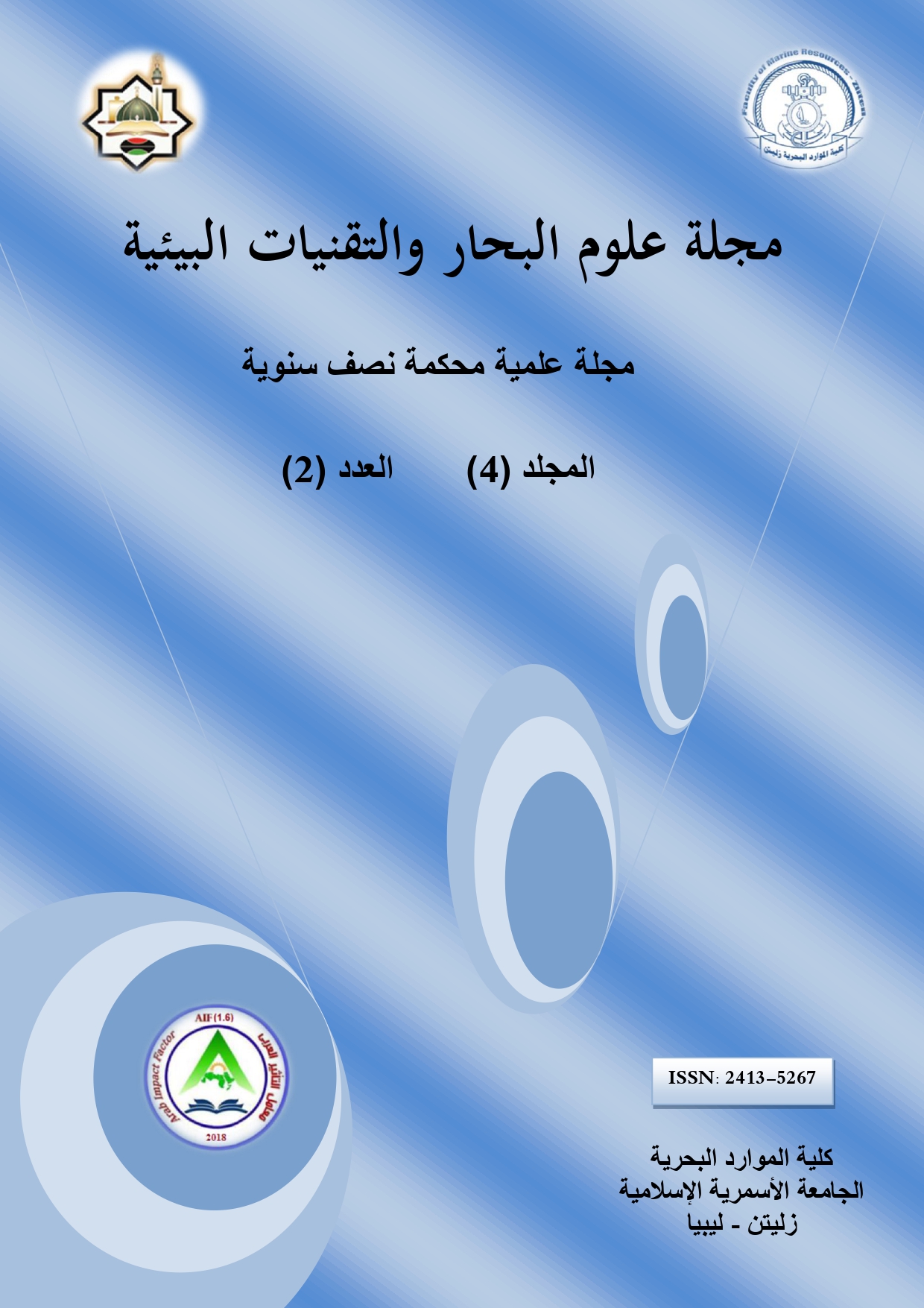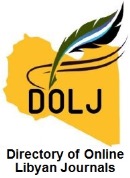حركة الكادميوم في عمود من التربة الصحراوية الرملية المفككة والمعالجة بإضافة حمأة الصرف الصحي
DOI:
https://doi.org/10.59743/jmset.v4i2.77الكلمات المفتاحية:
حمأة الصرف الصحي، الكادميوم، ترب جافة، الحركية، الترشيحالملخص
الهدف الرئيسي من هذا البحث هو التنبؤ بحركة أيونات الكادميوم في عمود التربة المعامله بحمأة المجاري. حيث تمت دراسة تأثير إضافة الحمأة على حركية ايونات الكادميوم باستخدام أعمدة التربة، ولتقييم الحركة الرأسية للكادميوم في التربة الصحراوية المعاملة بمعدلات مختلفة من حمأة المجاري
(T1 = 0، T2 = 20، T4 = 60 وT3 = 40 طن/هكتار). وقد أظهرت النتائج المتحصل عليها أن الخصائص الفيزيائية للتربة المدروسة تحسنت بشكل ملحوظ بسبب إضافة حمأة المجاري؛ وان المادة العضوية في التربة ومساميتها تؤدي إلى زيادة قدرة الاحتفاظ بالمياه وهيكل التربة المدروسة. حمأة الصرف الصحي لديها القدرة على زيادة خصوبة التربة، وفي المقابل فان ارتفاع بعض المعادن الثقيلة في التربة المعاملة له تأثير سلبي على إعادة الاستخدام. كانت تراكيز الكادميوم أعلى عند معدل الإضافة (T4) حوالي (14.2 مجم/كجم). ووفقًا للنتائج، أسفرت إضافة حمأة المجاري إلى الأعمدة المختبرة عن تراكيز كبيرة من الكادميوم في مياه الراشح. حيث احتوت مياه راشح عمود التربة عند معدل الإضافة 60 طن/هكتار على تركيز أعلى من الكادميوم (3.03 مجم/لتر). علاوة على ذلك، يختلف تركيز أيونات الكادميوم في التربة وفقًا للمعالجات مما أدى إلى التتابع التالي
(T1) <(T2) <(T3) <(T4). وقد تباين توزيع ايونات الكادميوم على طبقات التربة في العمود الواحد. وبشكل عام، وجد ارتباط وثيق بين حركة عنصر الكادميوم في التربة المعاملة بالحمأة بالمواد العضوية ودرجة الحموضة r = (0.71439) و (0.0.94886) r = و r = (0.70965) و(0.99047) r = على التوالي.
التنزيلات
المراجع
Adriano D.C. (2001). Trace elements in terrestrial environments. Biogeochemistry, Bioavailability, and Risks of Metals. Springer-Verlag New York.
Aishah R.M., Shamshuddin J., Fauziah C.I, Arifin A., and Panhwar Q.A. (2016). Phytoremediation of copper and zinc in sewage sludge amended soils using Jatropha Curcas and Hibiscus Cannabinus. Journal of The Chemical Society of Pakistan, 38: 1230-1243
Aishah R.M., Shamshuddin J., Fauziah C.I., Arifin A., and Panhwar Q.A. (2018). Adsorption-desorption characteristics of zinc and copper in Oxisol and Ultisol amended with sewage sludge. Journal of The Chemical Society of Pakistan, 40(5): 842-855.
Alloway B.J., and Jackson A.P. (1991). The behavior of heavy metals in sewage sludge amended soils. The Science of The Total Environment, 100: 151-176.
Alvarenga P., Mourinha C., Farto M., Santos T., Palma P., Sengo J., Morais M., and Cunha-Quedab C. (2015). Sewage sludge, compost and other representative organic wastes as agricultural soil amendments: benefits versus limiting factors. Waste Management, 40: 44–52.
Anderson J.M., and Ingram J.S.I. (1993). Tropical soil biology and fertility: A Handbook of Methods. CAB International, United Kingdom.
Arao T., Ishikawa S., Murakami M., Abe K., Maejima Y., and Makino T. (2010). Heavy metal contamination of agricultural soil and countermeasures in japan. Paddy Water Environ., 8(3): 247–257.
ASTM (2000). Standard test methods for moisture, ash, and organic matter of peat and other organic soils. Method D 2974-00. American Society for Testing and Materials. West Conshohocken, PA.
Benitez E., Romero M., Gomez M., Gallardolaro F., and Nogales R. (2001). Bio-solid and bio-solid ash as sources of heavy metals in plant-soil system. Water, Air and Soil Pollution, 132(1-2): 75-87.
Bettiol W., and Ghini R. (2011). Impacts of sewage sludge in tropical soil: a case study in brazil. Applied and Environmental Soil Science, 6: 1-11.
Blanco H. and Lal R. (2010). Principles of soil conservation and management. Vol. 167169, Springer Dordrecht Heidelberg, London.
Bozkurt M.A., and Cimrin K.M. (2003). The effects of sewage sludge applications on nutrient and heavy metal concentration in a calcareous soil. Fresenius Environmental Bulletin, 12(11): 1354 – 1360.
Camobreco V.J., Richards B.K., Steenhuis T.S., Peverly J.H., and Mcbride M.B. (1996). Movement of heavy metals through undisturbed and homogenized soil columns. Soil Science, 161(11): 740-750.
Cook M.E. (1994). Cadmium pigments: when should i use them?, Inorganic pigments. Environmental issues and technological opportunities, industrial inorganic chemicals group, Royal Society of Chemistry, London.
Council for Agricultural Science and Technology (CAST). (1976). Application of sewage sludge to cropland appraisal of potential hazards of the heavy metals to plants and ammals. EPA Report No. 430/9-76-013. U. S. Environmental Protection Agency, Office of Water Program Operations, Washington DC.
Csavina J., Field J., Taylor M.P., Gao S., Landazuri A., Betterton E.A., and Saez A.E. (2012). A Review on the importance of metals and metalloids in atmospheric dust and aerosol from mining operations. Sci. Total Environ., 433: 58–73.
Griffiths J.F. (1972). Climates of Africa. World survey of climatology, vol. 10. Elsevier publish. Comp., Amsterdam,
Grossman R.B., and Reinsch T.G. (2002). Bulk density and linear extensibility. Methods of soil analysis: Part 4 physical methods methods of soil, 4: 201-228.
Heinrichs H., Schulz-Dobrick B., and Wedepohl K.H. (1980). Terrestrial geochemistry of Cd, Bi. Ti, Pb, Zn, and Rb. Geochim. Cosmochim. Acta., 44: 1519-1532.
Justin V., Majid, N.M., Islam, M.M., and Abdu A. (2011). Assessment of heavy metal uptake and translocation in Acacia mangium for phytoremediation of cadmium-contaminated soil. Journal of food, Agriculture, and Environment, 9(2): 588-592.
Kettler T.A., Doran J.W., and Gilbert T.L. (2001). Simplified method for soil particle-size determination to accompany soil-quality analyses. Soil Science Society of America Journal, 65(3): 849-852.
Mamindy-Pajany Y., Sayen S., and Guillon E. (2013). Impact of sewage sludge spreading on nickel mobility in a calcareous soil: adsorption–desorption through column experiments. Environmental Science and Pollution Research., 20: 4414–4423.
Mayouf J.A., Najim Q.A., and Al-Bayati H.S. (2014). Determination of cadmium and lead in sewage sludge from the middle region (Misrata, Msallata and Tarhünah Cities) of Libya. International Journal of Chemical and Molecular Engineering, 8(9): 1073-1076.
Mihai F. C. (2017). Solid waste management in rural areas. Publishing Process Manager Mirena Calmic.
Milinovic J., Vidal M., Lacorte S., and Rigol A. (2014). Leaching of heavy metals and alkylphenolic compounds from fresh and dried sewage sludge. Journal of Environmental Science and Pollution Research, 21(3): 2009-2017.
Nelson D.W, and Sommers L.E. (1982). Total carbon, organic carbon, and organic matter. Methods of soil analysis. Part 2. Chemical and microbiological properties methods of soil, 2: 539-579.
Shaheen A., and Iqbal J. (2018). Spatial distribution and mobility assessment of carcinogenic heavy metals in soil profiles using geostatistics and random forest, Boruta Algorithm. Sustainability, 10(3): 799.
Sherene T. (2010). Mobility and transport of heavy metals in polluted soil environment. Biological Forum - An International Journal, 2(2): 112-121.
Sterritt R.M., and Lester J.N. (1980). The value of sewage sludge to agriculture and effects of the agricultural use of sludges contaminated with toxic elements: a review. The Science of The Total Environment, 16: 55-90.
Sundström R., Åström M., and Ősterholm P. (2002). Comparison of the metal content in acid sulfate soil runoff and industrial effluents in Finland. Journal of Environmental Science and Technology, 36(20): 4269-4272.
U.S. EPA. (1993). Clean Water Act, Sec. 503, (58): 32. U.S. Environmental Protection Agency, Washington D.C.
Udom, B.E., Mbagwu J.S.C., Adesodun J.K., and Agbim N.N. (2004). Distributions of zinc, copper, cadmium and lead in a tropical Ultisol after long-term disposal of sewage sludge. Journal of Environment International, 30(4): 467-470.
Violante A., Cozzolino V., Perelomov V. L., Caporale A.G., and Pigna J.M. (2010). Mobility and bioavailability of heavy metals and metalloids in soil environments. Journal of Soil Science and Plant Nutrition, 10(3): 268-292.
Wang H., Xia W., and Ping P. (2017). Study on adsorption characteristics of biochar on heavy metals in soil. Korean J. Chem. Eng., 34(6): 1867-1873.
Zheng S.A., Zheng X., and Chen C. (2012). Leaching behavior of heavy metals and transformation of their speciation in polluted soil receiving simulated acid rain. PloS One, 7(11): e49664.
التنزيلات
منشور
إصدار
القسم
الرخصة
الحقوق الفكرية (c) 2018 مجلة علوم البحار والتقنيات البيئية

هذا العمل مرخص بموجب Creative Commons Attribution 4.0 International License.












